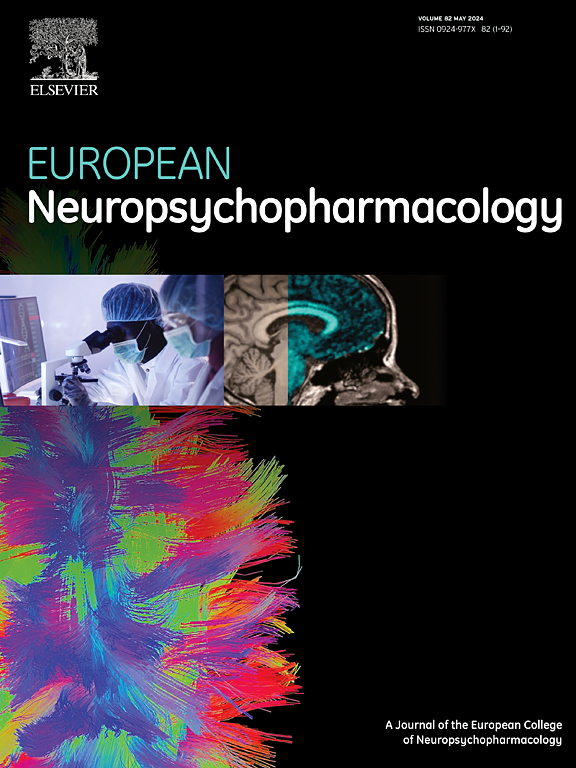创伤后应激障碍和大脑形态的共同遗传结构
IF 6.7
2区 医学
Q1 CLINICAL NEUROLOGY
引用次数: 0
摘要
创伤后应激障碍(PTSD)与大脑整体、皮层下和皮层形态以及区域白质测量的改变有关。然而,导致PTSD患者大脑差异的遗传机制尚不清楚。研究创伤后应激障碍的共同遗传结构和大脑形态学可能有助于揭示重叠的生物学途径,阐明创伤后应激障碍神经生物学的各个方面,并通过利用遗传相关的大脑特征信息来提高检测创伤后应激障碍遗传位点的能力。我们使用来自精神病学基因组学联盟(PGC-PTSD Freeze 3; N = 1,222,882)的GWAS汇总统计数据,并在UK Biobank (N = 33,735)中进行了脑形态学的单因素和多因素GWAS。大脑表型包括196个全球和区域测量,涵盖皮质厚度、表面积、皮质下体积和白质微观结构。使用MOSTest进行多变量GWAS,以确定跨大脑特征的共享遗传成分。使用连锁不平衡评分回归(LDSC)估计PTSD与脑表型之间的遗传相关性,并使用条件错误发现率(condFDR)分析检测共享位点,包括混合效应方向的位点。我们使用MiXer进一步评估多效性,该方法估计性状之间共有的因果变异的数量。为了整合这两个领域的遗传风险,我们应用了PleioPGS,一种多基因评分方法,结合了来自创伤后应激障碍和脑形态学的多效性信号,来估计来自ENIGMA联盟的22个独立队列中创伤后应激障碍和脑形态学的变异性。本研究探讨了常见的遗传变异在多大程度上共同导致PTSD和大脑结构,以及整合这两种来源的遗传信息是否能增强我们识别新的生物学机制的能力。这项工作的发现将确定遗传信息成像生物标志物,并加深对与PTSD相关的神经生物学途径的了解。本文章由计算机程序翻译,如有差异,请以英文原文为准。
THE SHARED GENETIC ARCHITECTURE OF PTSD AND BRAIN MORPHOLOGY
Post-traumatic stress disorder (PTSD) has been associated with alterations in global, subcortical, and cortical brain morphology, as well as regional white matter measures. However, the genetic mechanisms contributing to these brain differences in PTSD remain unknown. Investigating the shared genetic architecture of PTSD and brain morphology may help uncover overlapping biological pathways, clarify aspects of PTSD neurobiology, and improve the power to detect genetic loci for PTSD by leveraging information from genetically correlated brain traits.
We used GWAS summary statistics from the Psychiatric Genomics Consortium (PGC-PTSD Freeze 3; N = 1,222,882) and conducted both univariate and multivariate GWAS of brain morphology in the UK Biobank (N = 33,735). The brain phenotypes included 196 global and regional measures spanning cortical thickness, surface area, subcortical volume, and white matter microstructure. Multivariate GWAS was performed using MOSTest to identify shared genetic components across brain traits. Genetic correlation between PTSD and brain phenotypes was estimated using linkage disequilibrium score regression (LDSC), and conditional false discovery rate (condFDR) analysis was applied to detect shared loci, including those with mixed effect directions. We further assessed pleiotropy using MiXer, which estimates the number of causal variants shared between traits. To integrate genetic risk across both domains, we applied PleioPGS, a polygenic scoring method that incorporates pleiotropic signals from both PTSD and brain morphology, to estimate the variability explained for PTSD and brain morphology in 22 independent cohorts from the Enhancing NeuroImaging Genetics through Meta-Analysis (ENIGMA) consortium.
This study examines the extent to which common genetic variants contribute jointly to PTSD and brain structure, and whether integrating genetic information from both sources enhances our ability to identify novel biological mechanisms. Findings from this work will identify genetically informed imaging biomarkers and deepen insight into neurobiological pathways associated with PTSD.
求助全文
通过发布文献求助,成功后即可免费获取论文全文。
去求助
来源期刊

European Neuropsychopharmacology
医学-精神病学
CiteScore
10.30
自引率
5.40%
发文量
730
审稿时长
41 days
期刊介绍:
European Neuropsychopharmacology is the official publication of the European College of Neuropsychopharmacology (ECNP). In accordance with the mission of the College, the journal focuses on clinical and basic science contributions that advance our understanding of brain function and human behaviour and enable translation into improved treatments and enhanced public health impact in psychiatry. Recent years have been characterized by exciting advances in basic knowledge and available experimental techniques in neuroscience and genomics. However, clinical translation of these findings has not been as rapid. The journal aims to narrow this gap by promoting findings that are expected to have a major impact on both our understanding of the biological bases of mental disorders and the development and improvement of treatments, ideally paving the way for prevention and recovery.
 求助内容:
求助内容: 应助结果提醒方式:
应助结果提醒方式:


